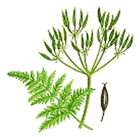
Myrrh
Introduction
This fact sheet provides basic information about Myrrh. The Commiphora species that serve as sources of myrrh are thorny shrubs or small trees that grow to up to 3 meters high. They are native to Africa, eastern Mediterranean countries, and South Arabia. A pale yellow-white viscous liquid exudes from natural cracks or fissures in the bark or from fissures cut intentionally to harvest the material. When air-dried, this exudate hardens into a reddish-brown mass that often contains white patches. These tears are approximately the size of a walnut and form the basis of myrrh resin. Myrrh is usually collected in the summer months. Though related, Commiphora mukul or "false" myrrh does not provide a source of myrrh, but rather guggulu resin, which is believed to lower cholesterol levels.Myrrh has been used for centuries as incense and for medicinal purposes. Medicinally, it has been used as an astringent, antiseptic, antiparasitic, antitussive, emmenagogue, and antispasmodic agent. It was commonly included in mixtures used to treat worms, wounds, and sepsis during the 4th century BC. Myrrh has also been reported to treat gout, headache, jaundice, throat ailments, indigestion, fatigue, and paralysis. Myrrh has been used in a variety of infectious diseases, including leprosy and syphilis, and to treat cancers. The Chinese have used myrrh in the management of a variety of skin and mouth infections. During the 10th century, myrrh was recommended to protect against plagues when travelling in endemic areas. It was also believed by the Greeks and Romans to be effective in the treatment of snake bites and is still used in parts of East Africa today for this indication. Myrrh was one of the first treatments of cough in children. Additionally, myrrh was incorporated as part of the mummification and cremation processes. Lotions containing myrrh have been made for use as cleansing agents, moisturizers, skin lesion treatments, and fragrances. Myrrh played a key role in the religious ceremonies of the ancient Egyptians. In the Bible, myrrh is cited as one of the 3 gifts (in addition to gold and frankincense) presented to Jesus by the Magi following his birth (Matthew 2:11) and was offered in a mixture of wine to Jesus during his crucifixion as an anesthetic (Mark 15:23). These gifts were a sign of wealth because they were rare and expensive. Myrrh is also a part of African, Middle Eastern, and Chinese traditional medicine. The Arabic term "murr" means "bitter" and describes myrrh's taste and balsamic odor. Today, myrrh is used as a component of fragrances and as an astringent in mouthwashes and gargles. It is sometimes used to flavor beverages and foods. The French and British continue to use myrrh in mixtures for the treatment of cough and in suppository form to treat proctitis.
Common Names
Myrrh, African Myrrh, Somali Myrrh, Arabian and Yemen Myrrh, Myrrha, Myrrhe, Gum Myrrh, Bola, Bal, Bol, HeerabolLatin Names
Commiphora myrrhaWhat It Is Used For
- Myrrh is used as a fragrance in cosmetics and as a flavoring agent in foods and beverages. It has also been used as an astringent, as an antiseptic to be applied to inflamed lesions of the throat and mouth, and as an emmenagogue and an antispasmodic, and for the treatment of cancer and infectious diseases. Myrrh also has a potential role in the treatment of schistosomiasis and fascioliasis; however, there is limited clinical information to support these uses.
How It Is Used
Myrrh may be administered as a tincture or in dental powders, tea, rinses, and gargles.- Tinctures: Paint or dab on the affected area(s) 2 to 3 times daily. Do not dilute the tincture.
- Tea: 1 to 2 teaspoonfuls of resin per 1 cup of boiling water, steep for 10 to 15 minutes and drink 3 times daily.
- Rinses: 5 to 10 drops in a glass of water.
- Gargles: 30 to 60 drops in a glass of water.
- Dental powders: Dental powders contain 10% of the powdered resin.
What the Science Says
- No clinical studies of myrrh in the treatment of GI disorders in humans have been documented.
- No clinical studies of myrrh in the treatment of diabetes in humans have been documented.
- No clinical studies of myrrh as an antitumor or anticarcinogenic agent in humans have been documented.
- Myrrh has demonstrated the ability to lower blood sugar levels. Use caution in patients also receiving antidiabetes medications, especially those that can lead to hypoglycemia. Careful monitoring of blood glucose is warranted.
Side Effects and Cautions
- No serious toxicities have been reported with myrrh. Myrrh is approved by the FDA for food use and was "given generally recognized as safe" status as a flavoring agent.
Sources
- Drugs.Com Web site. Accessed on February 7, 2009.
- From Wikipedia, the free encyclopedia. Accessed on February 7, 2009.






